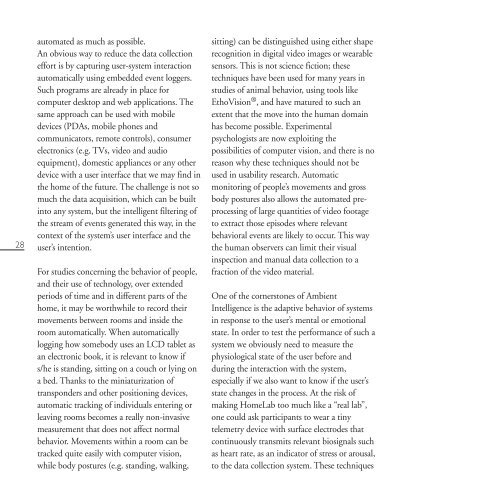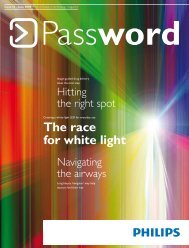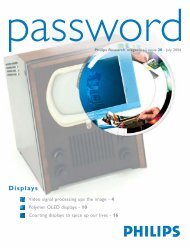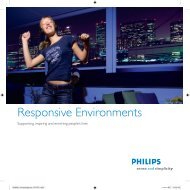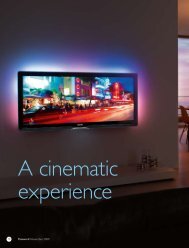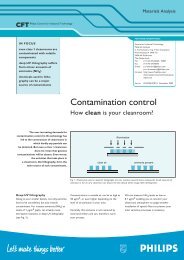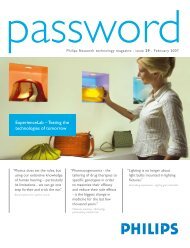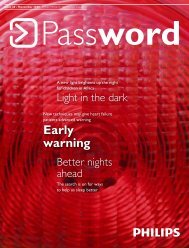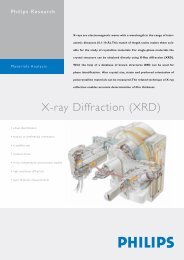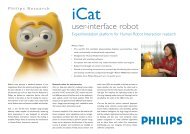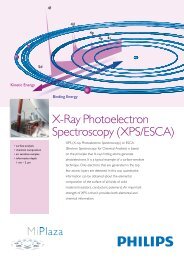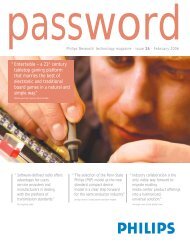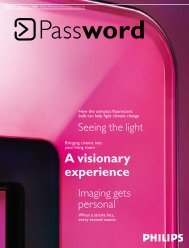365 DAYS AMBIENT INTELLIGENCE IN HOMELAB - Philips Research
365 DAYS AMBIENT INTELLIGENCE IN HOMELAB - Philips Research
365 DAYS AMBIENT INTELLIGENCE IN HOMELAB - Philips Research
You also want an ePaper? Increase the reach of your titles
YUMPU automatically turns print PDFs into web optimized ePapers that Google loves.
Ambient 05-05-2003 12:38 Pagina 28<br />
28<br />
automated as much as possible.<br />
An obvious way to reduce the data collection<br />
effort is by capturing user-system interaction<br />
automatically using embedded event loggers.<br />
Such programs are already in place for<br />
computer desktop and web applications. The<br />
same approach can be used with mobile<br />
devices (PDAs, mobile phones and<br />
communicators, remote controls), consumer<br />
electronics (e.g. TVs, video and audio<br />
equipment), domestic appliances or any other<br />
device with a user interface that we may find in<br />
the home of the future. The challenge is not so<br />
much the data acquisition, which can be built<br />
into any system, but the intelligent filtering of<br />
the stream of events generated this way, in the<br />
context of the system’s user interface and the<br />
user’s intention.<br />
For studies concerning the behavior of people,<br />
and their use of technology, over extended<br />
periods of time and in different parts of the<br />
home, it may be worthwhile to record their<br />
movements between rooms and inside the<br />
room automatically. When automatically<br />
logging how somebody uses an LCD tablet as<br />
an electronic book, it is relevant to know if<br />
s/he is standing, sitting on a couch or lying on<br />
a bed. Thanks to the miniaturization of<br />
transponders and other positioning devices,<br />
automatic tracking of individuals entering or<br />
leaving rooms becomes a really non-invasive<br />
measurement that does not affect normal<br />
behavior. Movements within a room can be<br />
tracked quite easily with computer vision,<br />
while body postures (e.g. standing, walking,<br />
sitting) can be distinguished using either shape<br />
recognition in digital video images or wearable<br />
sensors. This is not science fiction; these<br />
techniques have been used for many years in<br />
studies of animal behavior, using tools like<br />
EthoVision ® , and have matured to such an<br />
extent that the move into the human domain<br />
has become possible. Experimental<br />
psychologists are now exploiting the<br />
possibilities of computer vision, and there is no<br />
reason why these techniques should not be<br />
used in usability research. Automatic<br />
monitoring of people’s movements and gross<br />
body postures also allows the automated preprocessing<br />
of large quantities of video footage<br />
to extract those episodes where relevant<br />
behavioral events are likely to occur. This way<br />
the human observers can limit their visual<br />
inspection and manual data collection to a<br />
fraction of the video material.<br />
One of the cornerstones of Ambient<br />
Intelligence is the adaptive behavior of systems<br />
in response to the user’s mental or emotional<br />
state. In order to test the performance of such a<br />
system we obviously need to measure the<br />
physiological state of the user before and<br />
during the interaction with the system,<br />
especially if we also want to know if the user’s<br />
state changes in the process. At the risk of<br />
making HomeLab too much like a “real lab”,<br />
one could ask participants to wear a tiny<br />
telemetry device with surface electrodes that<br />
continuously transmits relevant biosignals such<br />
as heart rate, as an indicator of stress or arousal,<br />
to the data collection system. These techniques


